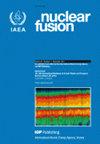由于有限离子轨道宽度效应而形成的径向边缘电场是 H 模式边缘的可能根本原因。
IF 4
1区 物理与天体物理
Q1 PHYSICS, FLUIDS & PLASMAS
引用次数: 0
摘要
热离子的全轨道跟踪模拟表明,有限离子轨道宽度效应会在最后一个封闭通量面(LCFS)附近产生电荷分离,从而产生局部径向电场。实验在 H 模式等离子体中观测到了边缘电场,它们是通过 E×B 流剪切机制抑制边缘湍流的必要条件。等离子体边缘附近受限的被困离子(其次是共通离子)在 LCFS 外形成正电荷分布,而热电子由于质量较小,与场线的束缚较紧,在 LCFS 外受限程度较低,因此在 LCFS 外违反了电荷中性原则。尽管模拟并不是完全自洽地进行的,但大量来自球形和常规托卡马克的观测报告支持了模拟结果。结果提出了降低 H 模式功率阈值和优化 H 模式等离子体边缘的方法。本文章由计算机程序翻译,如有差异,请以英文原文为准。
The formation of an radial edge electric field due to finite ion orbit width effects is the possible root cause of the H-mode edge
Full orbit-following simulations of thermal ions show that finite ion-orbit width effects create charge separation near the last closed flux surface (LCFS) which generates a localized radial electric field. Experimentally, edge electric fields are observed in H-mode plasmas and they are necessary for the edge turbulence suppression via the
E × B flow shear mechanism. Confined trapped (and to a lesser extent co-passing) ions near the plasma edge form a positive charge distribution outside the LCFS, while thermal electrons are tied more tightly to field lines owing to their small mass and are poorly confined outside the LCFS, hence charge neutrality is violated outside the LCFS. A large number of reported observations from spherical and conventional tokamaks support the results from the simulations although the simulations were not performed fully self consistently. The results suggest ways to lower the H-mode power threshold and optimize the H-mode plasma edge.
求助全文
通过发布文献求助,成功后即可免费获取论文全文。
去求助
来源期刊

Nuclear Fusion
物理-物理:核物理
CiteScore
6.30
自引率
39.40%
发文量
411
审稿时长
2.6 months
期刊介绍:
Nuclear Fusion publishes articles making significant advances to the field of controlled thermonuclear fusion. The journal scope includes:
-the production, heating and confinement of high temperature plasmas;
-the physical properties of such plasmas;
-the experimental or theoretical methods of exploring or explaining them;
-fusion reactor physics;
-reactor concepts; and
-fusion technologies.
The journal has a dedicated Associate Editor for inertial confinement fusion.
 求助内容:
求助内容: 应助结果提醒方式:
应助结果提醒方式:


